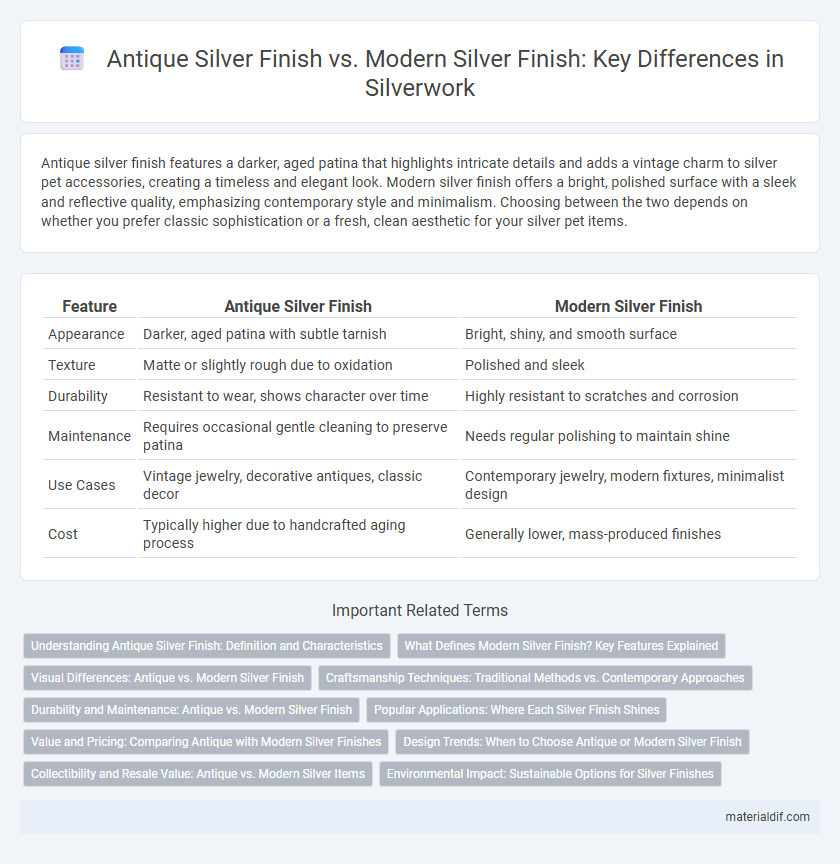Antique silver finish features a darker, aged patina that highlights intricate details and adds a vintage charm to silver pet accessories, creating a timeless and elegant look. Modern silver finish offers a bright, polished surface with a sleek and reflective quality, emphasizing contemporary style and minimalism. Choosing between the two depends on whether you prefer classic sophistication or a fresh, clean aesthetic for your silver pet items.
Table of Comparison
| Feature | Antique Silver Finish | Modern Silver Finish |
|---|---|---|
| Appearance | Darker, aged patina with subtle tarnish | Bright, shiny, and smooth surface |
| Texture | Matte or slightly rough due to oxidation | Polished and sleek |
| Durability | Resistant to wear, shows character over time | Highly resistant to scratches and corrosion |
| Maintenance | Requires occasional gentle cleaning to preserve patina | Needs regular polishing to maintain shine |
| Use Cases | Vintage jewelry, decorative antiques, classic decor | Contemporary jewelry, modern fixtures, minimalist design |
| Cost | Typically higher due to handcrafted aging process | Generally lower, mass-produced finishes |
Understanding Antique Silver Finish: Definition and Characteristics
Antique silver finish features a deliberately oxidized surface that enhances the metal's intricate details by creating a darker patina and aged appearance. This finish highlights the craftsmanship of silver pieces with subtle variations and a matte or slightly tarnished look that mimics natural aging. The contrast between the dark recesses and polished highlights defines the unique character and depth typical of antique silver items.
What Defines Modern Silver Finish? Key Features Explained
Modern silver finish is defined by its sleek, polished surface that emphasizes a smooth, reflective quality, often achieved through advanced electroplating techniques. Key features include uniform brightness, resistance to tarnish, and a cooler tone compared to the warmer, more textured appearance of antique silver finishes. This finish is favored for contemporary designs seeking a clean, shiny aesthetic with enhanced durability.
Visual Differences: Antique vs. Modern Silver Finish
Antique silver finish showcases a darker patina with intentional tarnishing and subtle imperfections that highlight its aged character, creating a warm, vintage appeal. Modern silver finish features a bright, polished surface with high reflectivity and uniform smoothness, emphasizing sleekness and contemporary style. The contrast in visual texture and sheen distinctly separates the timeless, rustic charm of antique silver from the crisp, clean look of modern silver finishes.
Craftsmanship Techniques: Traditional Methods vs. Contemporary Approaches
Antique silver finishes are crafted using traditional methods such as hand-hammering, acid etching, and oxidizing to create a patina that highlights intricate details and aged character. Modern silver finishes rely on contemporary techniques like electroplating, laser engraving, and precision polishing to achieve sleek, uniform surfaces with enhanced durability and reflective qualities. The contrast in craftsmanship techniques results in antique silver embodying historical authenticity, while modern silver emphasizes innovation and refined aesthetics.
Durability and Maintenance: Antique vs. Modern Silver Finish
Antique silver finishes feature a patina layer that enhances durability by providing resistance to tarnish and wear, requiring less frequent polishing compared to modern silver finishes. Modern silver finishes often have a brighter, smoother surface but tend to show scratches and tarnish more easily, necessitating more regular maintenance. Both finishes benefit from gentle cleaning with specialized silver polish to preserve their appearance and prolong lifespan.
Popular Applications: Where Each Silver Finish Shines
Antique silver finish is widely favored in vintage-inspired jewelry and decorative home accents for its rich, tarnished patina that adds historical character and depth. Modern silver finish dominates in contemporary tableware, electronic gadgets, and sleek architectural fixtures due to its smooth, reflective quality and minimalistic appeal. Both finishes are essential in fashion and interior design, with antique silver providing warmth and tradition, while modern silver offers a clean, futuristic vibe.
Value and Pricing: Comparing Antique with Modern Silver Finishes
Antique silver finishes often carry higher value due to their historical significance, unique patina, and craftsmanship, appealing to collectors and enthusiasts. Modern silver finishes tend to be more uniform and produced with contemporary techniques, generally resulting in lower market prices but greater accessibility. Pricing differences between antique and modern silver finishes reflect rarity, condition, and demand within vintage and contemporary markets.
Design Trends: When to Choose Antique or Modern Silver Finish
Antique silver finishes are ideal for design trends emphasizing vintage aesthetics, adding a warm patina and intricate texture that evoke historical charm in traditional or rustic interiors. Modern silver finishes complement contemporary design by offering sleek, polished surfaces with minimalist appeal that enhance bright, clean, and industrial-style spaces. Selecting between antique and modern silver finishes depends on the desired atmosphere, with antique finishes providing character and depth, while modern finishes highlight simplicity and sophistication.
Collectibility and Resale Value: Antique vs. Modern Silver Items
Antique silver finishes often hold higher collectibility and resale value due to their historical significance, craftsmanship, and rarity, attracting collectors and investors alike. Modern silver items typically feature contemporary designs and manufacturing techniques, which may appeal to current trends but generally lack the premium market demand of antiques. Provenance, condition, and hallmark authenticity further enhance the value of antique silver compared to modern silver goods.
Environmental Impact: Sustainable Options for Silver Finishes
Antique silver finishes often involve hand-applied patinas and polishing techniques that use fewer synthetic chemicals, reducing environmental toxicity compared to some modern silver finishes. Modern silver finishes frequently rely on electroplating and chemical treatments that can produce hazardous waste if not properly managed, impacting water and soil quality. Selecting sustainable silver finishes includes choosing processes with non-toxic materials, minimal waste, and technologies that recycle silver ions, contributing to lower environmental footprints in silver craftsmanship.
Antique silver finish vs Modern silver finish Infographic

 materialdif.com
materialdif.com